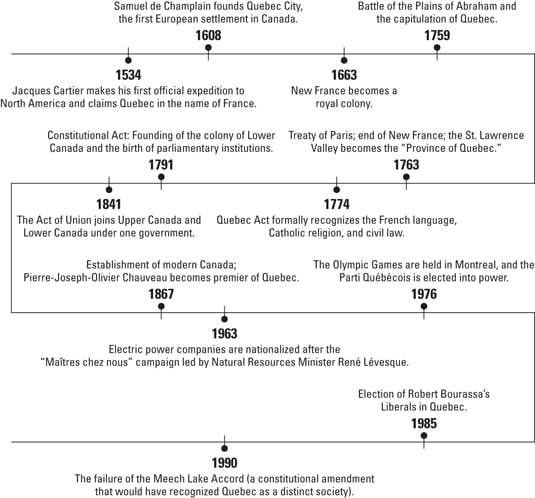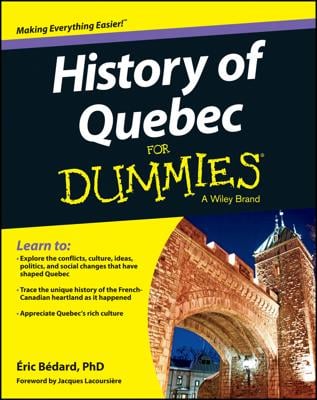Key dates in Quebec history
Since the arrival of the first European settlers, Quebec has had a tumultuous and eventful history. Take a look at the key events that have shaped Quebec:

Indigenous people of Quebec
When the Europeans colonizers first arrived, three main aboriginal groups populated the territory of Quebec: the Algonquians, Iroquoians, and Inuit people. Each was subdivided into tribes and occupied a specific part of the territory. Here’s a quick overview of the three groups:
-
The Algonquians: Made up of nomadic tribes, the Algonquian peoples were divided as follows:
-
The Montagnais (or Innu) roamed along the north shore of the St. Lawrence as far as the St. Maurice River.
-
The Cree lived south of James Bay; the Maliseet lived along the St. John River.
-
The Odawa inhabited the Témiscamingue region and the area north of Lake Huron.
-
The Algonquians covered an area along the north shore of the Ottawa and St. Lawrence rivers extending from the Témiscamingue region to west of the St. Maurice.
Other Algonquian tribal groups lived outside Quebec’s current boundaries (such as the Mi’kmaq of the maritime provinces and the Ojibwe of Lake Superior). The French settlers generally maintained good relations with these peoples.
-
-
The Iroquoians: When Jacques Cartier arrived from France in 1535, Iroquoian tribes were settled at Stadacona (in what is now called Quebec City) and Hochelaga (present-day Montreal). In the second half of the 16th century, they abandoned these posts and settled farther south and west.
When the French returned early in the 17th century, the Iroquoians had disappeared. Consisting mostly of semi-sedentary tribes, this major aboriginal family included the Iroquois, divided into the Five Nations of the Iroquois Confederacy — Mohawks, Oneidas, Onondagas, Cayugas, and Senecas. They lived in the areas around Lake Ontario and Lake Erie. The Hurons of the Great Lakes, with whom the French established close relations, were also part of the broader Iroquoian cultural family.
-
The Inuit: Completely isolated from the two other First Nation families in Quebec and from the early French colonists, the Inuit lived in Labrador and the far north.
Quebec sites of historical interest
Quebec’s diverse culture, history, and European feel make it a unique place for history buffs to explore. Here are some of the most well-known historic landmarks that the province has to offer:
-
The Plains of Abraham: At the time of the French regime, these plains were located outside Quebec and were used as pastureland for livestock. They were named in honor of Abraham Martin dit l’Écossais (“called the Scot”), who arrived in New France in 1619. He was one of the first settlers in the colony and the first pilote du roi (royal pilot) to navigate the St. Lawrence River. It was on the heights of the Plains of Abraham that the French and British armies squared off against each other for possession of Quebec on September 13, 1759. Today, these plains form the gathering place where Quebec City dwellers converge to celebrate Saint Jean-Baptiste Day every June 24. It’s a beautiful green space in the heart of an active, dynamic city.
-
Mount Royal: Located in the heart of Montreal Island, Mount Royal is a small hill with three peaks. Contrary to popular belief, Mount Royal was never an active volcano. When Montreal was first industrialized, Mount Royal became a focal area of urban development. The city’s rapid growth encouraged municipal authorities to protect Mount Royal as a green space. The city bought some of the land and hired Frederick Law Olmsted (1822–1903) to design a park. Olmsted was a leading landscape architect who designed Central Park in New York City. On May 24, 1876, Mount Royal Park was opened to the general public. From 1885 to 1918, people could go to the top by cable car. In 1938, a large artificial pond called Beaver Lake was completed. Thanks to its green spaces and hiking trails, Mount Royal Park became a peaceful haven for Montrealers from all parts of the city.
-
Île d’Orléans: Île d’Orléans is located on the St. Lawrence River, just east of Quebec City and Lévis, where the river’s two banks come closest to each other. This island has six municipalities and is one of the oldest areas of settlement in Quebec. More than 300 of Quebec’s old families have ancestors native to Île d’Orléans. The first land was granted in 1636, and five parishes were established between 1669 and 1679.
Île d’Orléans is the largest historic district in Quebec, with at least 600 historic buildings. These include many stone houses dating back to the French regime and some of the oldest Quebec churches. The charms of Île d’Orléans and fears that destruction of its heritage might be imminent were immortalized by the poet Félix Leclerc, who lived there from 1970 until his death in 1988, in his song “Le tour de l’île.”
-
The Quebec Citadel: The Quebec Citadel was part of the fortifications of the Quebec capital. Perched on Quebec City’s heights, and long nicknamed the “Gibraltar of America,” the Citadel ensured control of navigation on the St. Lawrence River and defended the colony against invaders. Some of its buildings date back to New France, but it was under British rule that it was fully completed in the early 1830s. The work of Lieutenant Colonel Elias Walker Durnford, the Citadel was designed by French engineer Sébastien Vauban.
-
Quebec has not been attacked since the winter of 1775–1776, so the Citadel was primarily used to garrison British troops stationed in Quebec. It was later home to the Royal Regiment of Canadian Artillery and, since 1920, to the only French-speaking regiment in the Canadian Forces, the 22nd Regiment, founded at the beginning of World War I.
-
During World War II, the Citadel hosted the deliberations of the two Quebec conferences that brought together British Prime Minister Winston Churchill and U.S. President Franklin Delano Roosevelt. The Citadel has also been the summer residence of the Governor General of Canada since the 19th century.

